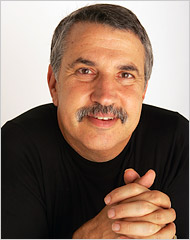By THOMAS L. FRIEDMAN
Published: March 23, 2010
President Obama’s winning passage of national health care is both exhilarating and sobering. Covering so many uninsured Americans is a historic achievement. But the president had to postpone trips, buy off companies and cut every conceivable side deal to just barely make it happen, without a single Republican vote. If the Democrats now lose seats in the midterm elections, we’re headed for even worse gridlock, even though we still have so much more nation-building for America to do — from education to energy to environment to innovation to tax policy. That is why I want my own Tea Party. I want a Tea Party of the radical center.
Thomas L. Friedman
Say what? I write often about innovation in energy and education. But I’ve come to realize that none of these innovations will emerge at scale until we get the most important innovation of all — political innovation that will empower independents and centrists, which describes a lot of the country.
Larry Diamond, a Stanford University democracy expert, put it best: “If you don’t get governance right, it is very hard to get anything else right that government needs to deal with. We have to rethink in some basic ways how our political institutions work, because they are increasingly incapable of delivering effective solutions any longer.”
My definition of broken is simple. It is a system in which Republicans will be voted out for doing the right thing (raising taxes when needed) and Democrats will be voted out for doing the right thing (cutting services when needed). When your political system punishes lawmakers for the doing the right things, it is broken. That is why we need political innovation that takes America’s disempowered radical center and enables it to act in proportion to its true size, unconstrained by the two parties, interest groups and orthodoxies that have tied our politics in knots.
The radical center is “radical” in its desire for a radical departure from politics as usual. It advocates: raising taxes to close our budgetary shortfalls, but doing so with a spirit of equity and social justice; guaranteeing that every American is covered by health insurance, but with market reforms to really bring down costs; legally expanding immigration to attract more job-creators to America’s shores; increasing corporate tax credits for research and lowering corporate taxes if companies will move more manufacturing jobs back onshore; investing more in our public schools, while insisting on rising national education standards and greater accountability for teachers, principals and parents; massively investing in clean energy, including nuclear, while allowing more offshore drilling in the transition. You get the idea.
How best to promote these hybrid ideas? Break the oligopoly of our two-party system. Diamond suggests two innovations. First, let every state emulate California’s recent grass-roots initiative that took away the power to design Congressional districts from the state legislature and put it in the hands of an independent, politically neutral, Citizens Redistricting Commission. It will go to work after the 2010 census and reshape California’s Congressional districts for the 2012 elections. Henceforth, districts in California will not be designed to be automatically Democratic or Republican — so more of them will be competitive, so more candidates will only be electable if they appeal to the center, not just cater to one party.
Second, get states to adopt “alternative voting.” One reason independent, third-party, centrist candidates can’t get elected is because if, in a three-person race, a Democrat votes for an independent, and the independent loses, the Democrat fears his vote will have actually helped the Republican win, or vice versa. Alternative voting allows you to rank the independent candidate your No. 1 choice, and the Democrat or Republican No. 2. Therefore, if the independent does not win, your vote is immediately transferred to your second choice, say, the Democrat. Therefore, you have no fear that in voting for an independent you might help elect your real nightmare — the Republican. Nothing has held back the growth of independent, centrist candidates more, said Diamond, “than the fear that if you vote for one of them you will be wasting your vote. Alternative voting, which Australia has, can overcome that.”
Obama won the presidency by tapping the center — centrist Democrats, independents and Republicans who wanted to see nation-building at home “to make their own lives and those of others better,” said Tim Shriver, the C.E.O. of the Special Olympics. They saw in Obama a pragmatist who could pull us together for pragmatic solutions. But hyperpartisanship has frustrated those hopes. (Alas, though, it is not equal. There are still many conservative Blue Dog Democrats, but the liberal Rockefeller Republicans have been wiped out.) If that radical center wants to be empowered, it can’t just whine. It needs its own grass-roots movement to promote reforms like nonpartisan redistricting and alternative voting in every state. It’s tea time for the center.
